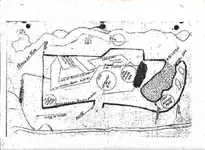Good points all. In the 1930s (and even before), there were people with lots of gold coins who needed a way to sidestep the long-anticipated legislation finally enacted by FDR that made it illegal to possess US gold coins or certified bullion. The coins were melted down and recast into crude bullion bars. Because of the uncertainty in the US economy and the expected devaluation of the US dollar (increase in the value of gold), the owners desired to illegally hoard the crude bullion bars. They created numerous "cave of gold bars" treasure tales and such, then released them to the public via newspaper articles, magazine articles, local rumors, "discovered documents", etc. This is why so many treasure legends POOF! surfaced in the 30s.
These fabricated treasure tales established a phony "history" for the existence of the gold they were holding, so that if and when they decided later to unearth the bullion, they had options available that would benefit them. First, they could rightfully claim a "treasure trove recovery" based on the existing laws in the state where the gold was hidden (whether it was physically hidden there or not). They also had the option of blending the bullion through legitimate mining companies (which they may have owned or influenced). They could also sell the bullion to foreign agents. Either way, they profited from the dollar devaluation, which increased the value of gold from 20 to 35 US dollars per ounce - and they were dealing in safer untraceable bullion, not highly identifiable US coinage.
Their fabricated treasure tales established a location, provided participants' names (real or phony), landmarks (real or phony) and enough other detail to sound convincing. Their bullion may even have been hidden in the legend's vicinity, but of course in a place unattainable for any searchers who accepted the tale at face value. Here we are, now 80 years or more later, and people are still searching for these things. Well, who knows, maybe some of the caches are still there. And the "treasure maps"? Why does anyone, even the most gullible, believe there is any reason that a genuine map capable of leading him to a hidden treasure could possibly become available to the public? Go figure.



 ).
).


